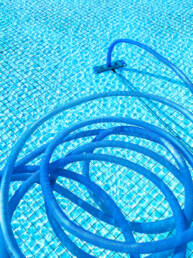As Denver begins to thaw and the sun lingers longer in the sky, it’s officially time to prepare your pool for the season ahead. A proper spring pool opening not only ensures your water stays crystal clear—it also protects your equipment, saves you money on repairs, and sets the stage for a summer full of safe, splash-filled fun.
At Laguna Pools, we know exactly what it takes to bring a backyard pool back to life after a long Colorado winter. Whether you’re a seasoned pool owner or opening your pool for the first time, this step-by-step checklist will help you get everything in order. And if you’d rather leave it to the pros, our expert team is ready to handle your spring pool opening from start to finish.
Remove the Pool Cover and Clean the Surface
After a long Denver winter, your pool cover has done its job—shielding your water from leaves, snow, debris, and UV damage. But before you dive into pool season, you need to safely and thoroughly remove the cover to avoid making a mess of your freshly thawed water.
Step 1: Clear Off the Cover
Start by removing loose debris from the cover. Use a leaf blower, skimmer net, or even a soft broom to gently push away twigs, leaves, and dirt. This prevents that buildup from falling into the pool when the cover is lifted.
If your cover is a solid tarp or vinyl, it may have accumulated standing water. Use a submersible pump or wet/dry vacuum to remove this excess water carefully. Never attempt to remove the cover with water still on it—it’s heavy, messy, and risks dragging gunk into your clean water.
Step 2: Remove the Cover Without Contamination
Once clear and dry, have at least one other person help you slowly fold or roll the cover back. This minimizes the chance of debris slipping off the edges into the pool. As you remove it, keep the cover off the ground to avoid picking up more dirt.
Step 3: Clean, Dry, and Store It Properly
Lay the cover out on a flat surface (driveways work great) and spray it down with a hose. Use a mild soap if needed to remove grime or mildew stains. Let it fully dry in the sun before folding it—this prevents mold growth and unpleasant odors during storage.
Store it in a durable container or storage bag in a cool, dry place like a shed or garage to keep pests, moisture, and UV damage at bay.
Step 4: Tidy the Pool Surface
With the cover off, you’ll likely see some leaves, bugs, or surface scum that made it through during the off-season. Use a leaf net or surface skimmer to scoop out floating debris. Then, run a manual or automatic vacuum across the pool floor to pick up any sediment that settled during winter.
Don’t forget the deck! Sweep and hose down the surrounding area to stop more dirt from blowing into the pool after all your hard work.
Inspect Pool Equipment
Before flipping any switches or turning on your pump, it’s essential to give your pool equipment a full visual and functional inspection. Cold Colorado winters can be hard on your pool system, especially if components weren’t fully winterized or have aged over time. Identifying any issues now can save you time, money, and frustration once the swim season kicks off.
Step 1: Reconnect Equipment and Components
If you removed equipment or fittings during fall winterization, now’s the time to reconnect:
- Replace drain plugs on the pool pump, filter, and heater.
- Reattach hoses, unions, and valves, making sure everything is tightened properly.
- Remove any winterizing plugs or gizmos from the skimmer and return lines.
Make sure all connections are firm but not over-tightened—damaged threads can lead to leaks or equipment failure.
Step 2: Inspect for Winter Damage
Denver’s freeze-thaw cycles can cause even small cracks to expand. Check for:
- Cracks or warping on the pump housing and filter tank.
- Signs of dry rot, cracking, or brittleness on O-rings, gaskets, and seals.
- Visible leaks around valves or pipe fittings.
- Corrosion or mineral buildup, particularly around heater connections or older plumbing.
If you’re unsure what to look for, Laguna Pools can provide a full equipment inspection as part of your spring opening service.
Step 3: Check Saltwater or Automation Systems
If you have a saltwater pool, inspect your chlorine generator cell. Clean off any calcium scale or mineral deposits using a cell-safe acid wash. For pools with automation systems, power them up and check for:
- Error codes or alerts on the controller.
- Sensor calibration (temperature, salt levels, pH, etc.).
- Proper functioning of timers, lights, and water features.
Step 4: Top Off the Water
Once all systems look good, start adding water to reach the normal operating level—typically halfway up the skimmer opening. This will ensure the pump can prime properly once it’s turned on.
Test and Balance Water Chemistry
Once your pool is physically clean and refilled to the proper water level, it’s time to tackle what many consider the most important part of pool care: balancing your water chemistry. Even crystal-clear water can be chemically imbalanced, which can lead to eye and skin irritation, algae growth, cloudy water, and damage to your equipment and finishes.
Why Water Balance Matters in Denver’s Climate
The dry air and fluctuating temperatures common in Colorado can impact your water chemistry more than you might expect. With Denver’s altitude and UV exposure, maintaining proper chlorine and stabilizer levels is especially important to protect your sanitizer from breaking down too quickly in the sun.
Step 1: Perform a Full Water Test
Whether you’re using a DIY liquid kit, test strips, or bringing a sample to a local pool store, here are the key chemical levels to assess:
- pH (7.4–7.6): Controls water acidity. Low pH = corrosion risk; high pH = cloudy water and scale.
- Total Alkalinity (80–120 ppm): Helps stabilize your pH. Fluctuating alkalinity makes the rest of your chemistry harder to manage.
- Calcium Hardness (200–400 ppm): Protects plaster and equipment from corrosion or scaling.
- Chlorine or Sanitizer Levels (1–3 ppm for chlorine, 3–5 ppm for salt systems): Keeps bacteria and algae at bay.
- Cyanuric Acid (CYA) (30–50 ppm): Acts as a stabilizer, shielding chlorine from UV degradation in outdoor pools.
If you use a saltwater system, also test salinity levels to ensure your generator can function properly.
Step 2: Adjust Carefully
Add chemicals one at a time and give them time to circulate before retesting—rushing the process can lead to imbalances and wasted products. Always:
- Pre-dissolve powders in a bucket if needed.
- Pour chemicals slowly and near return jets to aid distribution.
- Never mix chlorine with acid-based products.
Expert Tip:
If you’re feeling unsure about any part of the balancing process, Laguna Pools can test and balance your water professionally using advanced tools and expert insight. We’ll ensure your pool is clean, clear, and chemically safe—no guesswork required.
Run the System and Shock the Pool
Once your water is chemically balanced, the next step is to start circulating your pool water and perform an initial sanitation shock. These two steps work hand-in-hand to kickstart your pool into full operational mode.
Step 1: Prime and Start the Pool System
With all plumbing reconnected and the water level topped off, it’s time to turn on your circulation system. Here’s how to do it safely and effectively:
- Open your air relief valve to release trapped air in the filter system.
- Turn on the pump and allow it to run continuously for 24 to 48 hours. This promotes full circulation and gives your chemical treatments a chance to stabilize.
- Watch your pressure gauges for irregular spikes—it may be a sign of clogged filters or restricted flow.
- Inspect for leaks at valves, fittings, or union connections, especially if the system was drained over winter.
Step 2: Shock the Pool
Even if your pool appears clean, bacteria and algae spores can linger after months of stagnation. Shocking your pool—also known as superchlorination—raises the chlorine level high enough to sanitize the water quickly and effectively.
To shock your pool:
- Use a chlorine-based shock product (calcium hypochlorite or dichlor are common).
- Apply in the evening or on a cloudy day to prevent UV burn-off.
- Keep your pump running during and after treatment for at least 8 hours.
- Wait to swim until chlorine levels return to 1–3 ppm (test with a reliable kit).
Step 3: Backwash or Clean the Filter
After the initial shock and circulation, your filter has likely picked up debris and dead organic material. Whether you use a sand, cartridge, or DE filter, now is the time to:
- Backwash (for sand/DE filters) until the sight glass runs clear.
- Rinse and reinstall (for cartridge filters) after hosing off debris.
A clean filter improves system performance, ensures better water clarity, and prolongs the life of your equipment.
Final Touches Before You Dive In
You’ve cleaned, inspected, tested, and shocked—your pool is nearly ready to go. But before you invite friends over for that first backyard swim of the season, take a few final steps to ensure your outdoor space is not only safe and functional but also relaxing and inviting.
Reinstall Pool Accessories
Now’s the time to bring your pool area back to life with the essentials that make it safe, accessible, and enjoyable:
- Ladders and handrails: Reinstall all ladders, rails, and diving boards, checking for rust, corrosion, or loose bolts. These features are critical for safety—especially if children or older adults will be using the pool.
- Deck and poolside furniture: Pull out your lounge chairs, side tables, umbrellas, and sunshades. Give them a quick clean with mild soap and water to remove any dirt or mildew from winter storage.
- Pool lighting: Test all underwater and landscape lighting. Replace burnt-out bulbs and check timers or automation systems if you’re using smart lighting controls. Proper lighting adds ambiance and extends swim time into the evening.
- Safety equipment: If you have fences, self-latching gates, alarms, or pool covers, double-check that everything is functioning as intended. Colorado homeowners with young kids or pets should also confirm compliance with local pool safety regulations.
Clean and Store Winter Gear
Don’t forget to give your off-season supplies the care they need, too. Take your time to:
- Clean and dry your winter cover completely before folding it. Moisture can lead to mold and mildew, shortening its lifespan.
- Store winter plugs, skimmer guards, air pillows, and any antifreeze containers in a labeled storage bin in a dry, temperature-controlled area like your garage or a shed. Keeping everything organized makes fall closing that much easier.
Enjoy a Clean, Clear Pool
Once your accessories are in place and the water has circulated for a day or two, perform a final water test. You’re checking to make sure chemical levels—especially chlorine—have stabilized within safe swimming ranges.
When everything is balanced, the water is sparkling, and your space is refreshed, it’s officially time to celebrate the start of pool season.
Pro Tip: Plan a low-key spring “pool warming” party with close family or neighbors. It’s the perfect way to enjoy your hard work—and show off your sparkling clean pool, courtesy of Laguna Pools!
Call in the Pros: Let Laguna Pools Handle It All
Let’s face it—opening your pool after a long Colorado winter can be more work than it looks. Between reconnecting equipment, balancing tricky water chemistry, and checking for freeze damage, there’s a lot that can go wrong if you’re not experienced. If you’re short on time, tools, or just want the peace of mind that everything’s done right, it’s time to bring in the professionals.
At Laguna Pools, we take the stress and guesswork out of spring pool openings so you can skip straight to enjoying your pool—not troubleshooting it.
Why Trust Laguna Pools With Your Pool Opening?
We’re proud to be Denver’s trusted pool experts, known for exceptional service, reliable maintenance, and custom solutions for every backyard. When you schedule a spring pool opening with Laguna Pools, here’s what you can expect:
- Cover Removal & Cleaning: We’ll safely remove and clean your winter cover, then store it properly so it’s ready for next season.
- Detailed Equipment Inspection: From pumps and heaters to saltwater systems and valves, we check it all for damage or wear and ensure everything is ready to run.
- Professional Water Testing & Chemical Balancing: Using precision tools and expert knowledge, we adjust your pool chemistry to ensure sparkling, swim-ready water.
- Pump & Filtration System Startup: We prime the system, watch for leaks, monitor pressure, and make sure water is circulating efficiently.
- Shock Treatment & Surface Cleaning: Our technicians sanitize your pool and remove any early-season debris or sediment.
Bonus: Weekly and Biweekly Maintenance Options
Want your pool to stay clear and clean all season? Ask about our customizable maintenance plans, including:
- Skimming, brushing, and vacuuming
- Filter cleaning and equipment checks
- Regular chemical balancing
- Emergency service calls if something goes wrong
Our team is here to support you whether you need a one-time opening service or season-long pool care in the Denver metro area.
Ready to Jump In?
Book your spring pool opening with Laguna Pools today and let us take care of the dirty work—so you can focus on relaxing, entertaining, and enjoying every sun-soaked moment by the pool.

Ready for an expert opinion? Get in touch today!
Laguna Pools is a professional pool and spa contractor that has been servicing the Denver area for over 20 years. We offer routine cleaning and maintenance services, new pool design, construction, and remodeling.
Like this article? Spread the word!
Related Posts
February 10, 2025
Is Weekly Pool Maintenance Worth It? The #1 Reason Denver Homeowners Say Yes
Looking for hassle-free pool care? Discover the benefits of weekly pool maintenance from…
January 15, 2025
Create A Backyard Oasis with Laguna Pools
Discover the Top 10 Pool Design Trends for 2025 with Laguna Pools, Denver's leading pool…
March 9, 2024
A Comprehensive Guide to Pool Safety: Protecting Your Family and Guests
Discover essential pool safety tips with Laguna Pools' Comprehensive Guide to Protecting…





